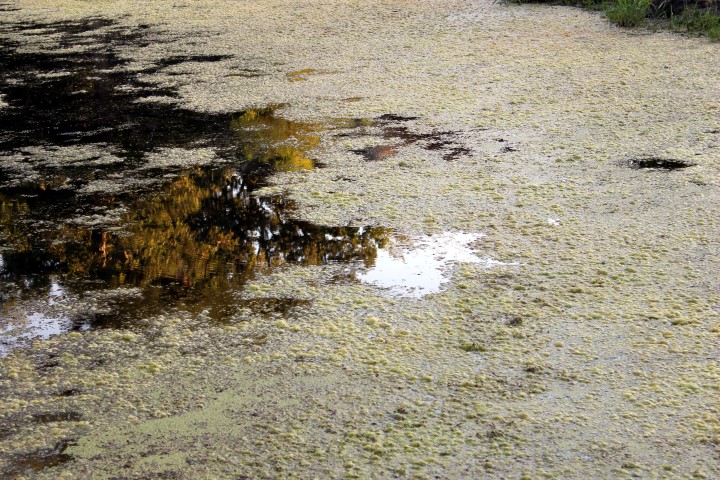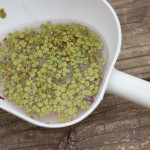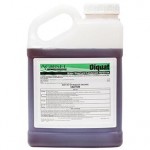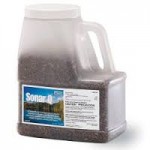Pipe & Pine DIY Closet
Want to see us on Youtube? Here’s our clicky American-Outdoors.netYouTube
Pipe & Pine DIY Closet
Want to see us on Youtube? Here’s our clicky American-Outdoors.netYouTube
If you have a pond with little aeration, or still water, lots of runoff, a nearby septic system that is failing, maybe near timber and/or decaying leaves and vegetation, even a buildup of sediment, then its a strong candidate for duckweed. Hi and welcome to American Outdoors.net. 
Duckweed, which I’ve also heard called Bayroot is a very small plant with 1 or more tiny leaves and a hair like root that floats right at the surface of the water. It is usually introduced into ponds from the feet or feathers of migrating ducks, geese or even small animals. My experience with duckweed is it is like a zombie; it’s difficult to kill completely, it will survive vast fluctuations in temperature and ph levels and flourishes in water sources rich in nitrogen and phosphorus.
Once it is in your pond, it will reproduce very quickly and can in short order completely cover it. This creates a smothering effect, blocking the plants below the surface from creating oxygen needed by fish. It’s no fun to swim in either.
The one positive I’m aware of are that it is a high protein food source. I’ve read that some folks like to eat it and consider it a super food. Good for them.
There are two methods to treating your pond against duckweed after the fact; naturally and chemically. I prefer the natural methods, however their effectiveness is limited more so before the fact. This pond is a small ground water pond, not quite a half acre in diameter and about a dozen feet deep in the middle. Duckweed first appeared here about two years ago. In less than two months, the entire water surface was covered with a green carpet of the stuff that was in some areas 2” thick. If this plant appears, and it usually shows up in the spring, you need to begin measures almost immediately, because if left unchecked, it can take years to eradicate and just because it may thin out or disappear in the fall doesn’t mean its gone. Duckweed sinks into the sediment of the pond and lies in wait over winter. Once the days grow long again and the sun returns, it’ll pop back up to the surface and get back to work. Grass carp are used as one means to reduce duckweed and we have stocked our pond with them in the past, but it is an over rated cure. They can only eat so much; my chickens eat duckweed too but it’s just a side dish to them. Aeration systems are all over the internet and they do make a difference. A properly set up unit can maintain a constant source of oxygen and agitate the surface to prevent standing or still water which is a breeding source waiting to happen. Electric, solar or even the windmill operated systems work. Expect to pay a thousand dollars and up for a setup designed for your size and depth pond.
The free method, which is may be effective but requires time, effort and later some muscle relaxants is to skim or rake the pond. It will not eliminate the problem, but considering how fast they spread over just a 24 hour period, it can keep the duckweed at a manageable level. 1 plant x 1 plant =2 plants. Easy to get rid of.
1 million x 1 million = 2 million. Not so easy.
Make a point to rake the plants up onto and past the bank. Leaving them along the water line won’t kill them; they’ll wash back with the next rain and start right where they left off.
So, knowing that natural or “organic” methods are limited in their effectiveness, there is plan “B”. Chemicals.
The first is called Diquat, or “Reward” as seen on store shelves. 
This is a contact herbicide that is usually comes in concentrated form, mixed with water and used in tank sprayers. It requires a surfactant, or an additive that adheres to the plant long enough for the diquat to take effect. That usually also comes concentrated and should be available locally. You’ll know it is working as the duckweed will turn brown in short order; what remains green will continue to crank out more duckweeds. The stuff isn’t too expensive, about $75 for a gallon and another $12-$15 for the surfactant, depending on the amount of water you need to treat. A drawback, in my opinion, is that it only lasts about a week, so it needs to be used often during the summer months.
Fluridone. or “Sonar” or also called “Avast”, needs much less effort. Typically an initial treatment followed up around two weeks later and the success rates are pretty high. It will remain active in the water for about a month and you don’t need to buy the surfactant. It is slower acting and results won’t appear as quickly as with the Diquat. It is also much more expensive, as a gallon can run $350 or more. 
Supposedly after a few days you can swim in it, let your dog drink out of it and fill your swimming pool up with it. I don’t know about any of that.
This pond was about 30% covered earlier this year and was treated with Diquat for about a month, with a lot of skimming and raking, using a pond rake, my wife and several minimum wage teenage offspring. You can see the difference now, and I expect it will continue to remain this way with only about an hour of work every week. By staying on top of the duckweed before it gets out of control, I hope to avoid spending any money on chemicals the rest of this year and next.
If you made it thru all of this, then I’m not as boring as I thought, and should you have any comments or questions about this video, hit us up at American-Outdoors.net. Thanks for watching and we’ll see you soon.